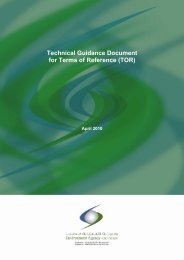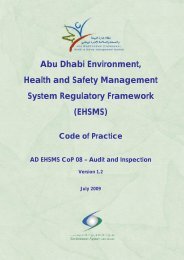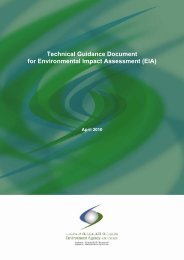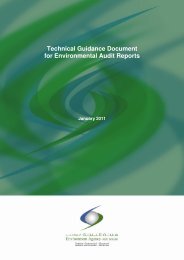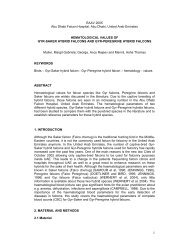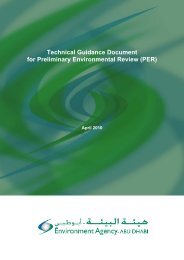Management options for the improvement of flamingo breeding at Al ...
Management options for the improvement of flamingo breeding at Al ...
Management options for the improvement of flamingo breeding at Al ...
Create successful ePaper yourself
Turn your PDF publications into a flip-book with our unique Google optimized e-Paper software.
<strong>Management</strong> <strong>options</strong> <strong>for</strong> <strong>the</strong> <strong>improvement</strong> <strong>of</strong><strong>flamingo</strong> <strong>breeding</strong> <strong>at</strong> <strong>Al</strong> W<strong>at</strong>hba Wetland Reserve_________________________________________________________________________________May 2004Terrestrial Environment Research CenterEnvironmental Research & Wildlife Development AgencyPO Box 45553, Abu DhabiUnited Arab Emir<strong>at</strong>es
<strong>Management</strong> <strong>options</strong> <strong>for</strong> <strong>the</strong> <strong>improvement</strong> <strong>of</strong> <strong>flamingo</strong> <strong>breeding</strong> <strong>at</strong><strong>Al</strong> W<strong>at</strong>hba Wetland ReserveTerrestrial Environment Research CenterProject Ref: 03-31-0002Project Title: Abu Dhabi Baseline SurveyDocument Ref. No: 03-31-0002/WSM/TP013Terrestrial Environment Research CenterEnvironmental Research & Wildlife Development AgencyPO Box 45553, Abu DhabiUnited Arab Emir<strong>at</strong>esTel: 971 2 68 17171Fax: 971 2 68 10008
<strong>Management</strong> <strong>options</strong> <strong>for</strong> <strong>the</strong> <strong>improvement</strong> <strong>of</strong> <strong>flamingo</strong> <strong>breeding</strong> <strong>at</strong> <strong>Al</strong>W<strong>at</strong>hba Wetland ReserveISSUE SHEETName Sign<strong>at</strong>ure D<strong>at</strong>ePrepared &submitted byChristophe TourenqChecked andapproved byJohn NewbyIssue St<strong>at</strong>usfinalPurpose <strong>of</strong> IssueInternal reportTeam Members<strong>Al</strong> Dhaheri, S.S.//Barcelo, I.//Drew,C.R.//Tourenq, C.//Authorised ByRef.03-31-0002/WSM/TP013REVISION SHEETRevision No. D<strong>at</strong>e Affected Pages D<strong>at</strong>e ChangeMadeBy (initials)
CONTENTSIntroduction ...........................................................................................................21. Is <strong>Al</strong> W<strong>at</strong>hba a suitable site <strong>for</strong> <strong>flamingo</strong> <strong>breeding</strong>?.....................................41.1. Breeding site quality ...................................................................................41.2. Foraging resources ....................................................................................71.3. Pred<strong>at</strong>ion/disturbance ..............................................................................101.4. Wea<strong>the</strong>r and Clim<strong>at</strong>e................................................................................102. Are <strong>Al</strong> W<strong>at</strong>hba <strong>flamingo</strong>s ready to breed?.................................................. 112.1. Group composition, structure and density ................................................122.2. Breeding range <strong>of</strong> <strong>the</strong> species, philop<strong>at</strong>ry and emigr<strong>at</strong>ion/immigr<strong>at</strong>ionprocesses........................................................................................................13Summary <strong>of</strong> proposed actions......................................................................... 15References cited ................................................................................................ 161
Introduction“The prime role <strong>of</strong> <strong>Al</strong> W<strong>at</strong>hba Wetland Reserve is to provide <strong>breeding</strong> habit<strong>at</strong> <strong>for</strong><strong>the</strong> Gre<strong>at</strong>er Flamingo (Phoenicopterus ruber) as well as to conserve biodiversityin all its <strong>for</strong>ms” (Perry and Kiwan 2000).The Gre<strong>at</strong>er Flamingo is a common visitor in <strong>the</strong> United Arab Emir<strong>at</strong>es and can beobserved all year round in lagoons and mudfl<strong>at</strong>s <strong>of</strong> <strong>the</strong> coast (Richardson 1990). After afirst <strong>breeding</strong> <strong>at</strong>tempt in 1993, <strong>the</strong> <strong>Al</strong> W<strong>at</strong>hba Wetland Reserve (hereafter “<strong>Al</strong> W<strong>at</strong>hba”)hosted in 1999 <strong>the</strong> first recorded <strong>breeding</strong> <strong>of</strong> <strong>the</strong> Gre<strong>at</strong>er Flamingo in <strong>the</strong> ArabianPeninsula since <strong>the</strong> last report from Kuwait in 1922 (Aspinall and Heyer 1999). Theunsuccessful <strong>breeding</strong> <strong>at</strong>tempts observed in March 2002 and November 2003 (Javedand Khan 2003) showed however th<strong>at</strong> <strong>Al</strong> W<strong>at</strong>hba is a potential <strong>breeding</strong> site <strong>at</strong>tracting<strong>flamingo</strong>s. Flooding <strong>of</strong> <strong>the</strong> nesting island due to <strong>the</strong> accidental or n<strong>at</strong>ural rise <strong>of</strong>w<strong>at</strong>erlevels was identified as <strong>the</strong> main reason <strong>for</strong> <strong>breeding</strong> failure in <strong>Al</strong> W<strong>at</strong>hba (Javedand Khan 2003). However, <strong>the</strong>re might be o<strong>the</strong>r reasons th<strong>at</strong> I review below with someproposals to tackle <strong>the</strong> issues on ei<strong>the</strong>r a short-term or a long-term basis.In <strong>flamingo</strong>s, as in o<strong>the</strong>r colonial w<strong>at</strong>erbird species, <strong>the</strong> colony dynamics, in particular<strong>the</strong> selection <strong>of</strong> <strong>the</strong> <strong>breeding</strong> site, is driven by multiple factors depending both on habit<strong>at</strong>quality and on <strong>the</strong> species (Kharitonov and Siegel-Causey 1988, Fasola and <strong>Al</strong>ieri 1992,Boulinier and Lemel 1996, Erwin et al. 1998).2
Clim<strong>at</strong>e-Wea<strong>the</strong>rHabit<strong>at</strong>characteristics- nesting site- food resourcesReproduction(<strong>breeding</strong>success)Pred<strong>at</strong>ion-DisturbanceDemographic parameters- popul<strong>at</strong>ion composition andstructure- <strong>breeding</strong> range, philop<strong>at</strong>ryand emigr<strong>at</strong>ion/immigr<strong>at</strong>ionFigure 1. Parameters driving reproduction in colonial w<strong>at</strong>erbirdsThe availability <strong>of</strong> food resources, <strong>the</strong> nesting site quality (e.g. suitable island,sufficient w<strong>at</strong>er levels <strong>for</strong> protection against pred<strong>at</strong>ors, etc) and <strong>the</strong> demographiccomponents [e.g. survival r<strong>at</strong>es, dispersal, philop<strong>at</strong>ry, proportion <strong>of</strong> m<strong>at</strong>ure males andfemales, etc…] will directly affect colony loc<strong>at</strong>ion, colony size and reproductiveparameters, i.e. <strong>the</strong> production <strong>of</strong> <strong>of</strong>fspring (Cezilly et al. 1995, Nager et al. 1996, Hafneret al. 1998, Reed et al. 1999, Bennets et al. 2000, Kushlan and Hafner 2000, Hafner etal. 2001, Rendon et al. 2001, Fasola et al. 2002).One <strong>of</strong> main <strong>the</strong> objectives <strong>of</strong> <strong>the</strong> <strong>Al</strong> W<strong>at</strong>hba Wetland Reserve management plan isto cre<strong>at</strong>e and manage a suitable <strong>breeding</strong> site <strong>for</strong> <strong>flamingo</strong>s (Perry and Kiwan 2000,Javed and Khan 2003). However, be<strong>for</strong>e predicting any regular <strong>breeding</strong> orlaunching any costly management actions, it is necessary to investig<strong>at</strong>e first <strong>the</strong>following questions:1) Is <strong>Al</strong> W<strong>at</strong>hba a suitable site <strong>for</strong> <strong>flamingo</strong> <strong>breeding</strong>?2) Is <strong>the</strong> current <strong>Al</strong> W<strong>at</strong>hba <strong>flamingo</strong> popul<strong>at</strong>ion ready to breed?3
1. Is <strong>Al</strong> W<strong>at</strong>hba a suitable site <strong>for</strong> <strong>flamingo</strong> <strong>breeding</strong>?Habit<strong>at</strong> quality issues have been identified below.1.1. Breeding site quality• Landscape characteristics <strong>of</strong> <strong>the</strong> <strong>breeding</strong> site: Flamingos are birds from “openlandscapes”:<strong>the</strong>y breed in open lakes, lagoons, artificial salt pans, seashores andeven freshw<strong>at</strong>er marshes (Johnson 1983) and avoid closed habit<strong>at</strong>s (i.e. with higherveget<strong>at</strong>ion, trees, hedges, bushes) th<strong>at</strong> prevent <strong>the</strong>m from seeing pred<strong>at</strong>ors and fromtaking-<strong>of</strong> easily (Tourenq et al. 2001). Successful <strong>breeding</strong> in 1998 and recent<strong>at</strong>tempts in <strong>Al</strong> W<strong>at</strong>hba showed th<strong>at</strong> <strong>the</strong> landscape characteristics <strong>of</strong> <strong>the</strong> site werenot a limiting factor <strong>for</strong> <strong>the</strong> <strong>breeding</strong> <strong>of</strong> <strong>flamingo</strong>s.• Substr<strong>at</strong>e quality <strong>of</strong> <strong>the</strong> nesting site: Flamingos nest on low islands <strong>of</strong> mud orsand, surrounded by w<strong>at</strong>er, and construct a nest-mound <strong>of</strong> <strong>the</strong> m<strong>at</strong>erial surrounding<strong>the</strong> nest. If <strong>the</strong> surface <strong>of</strong> <strong>the</strong> island is hard or dry, <strong>the</strong>re will be no mound, or ei<strong>the</strong>rno nest <strong>at</strong> all as in Mauritania and Kenya (Rendon Martos and Johnson 1996).Previous <strong>breeding</strong> <strong>at</strong>tempts have shown th<strong>at</strong> <strong>the</strong> soil substr<strong>at</strong>e in <strong>Al</strong> W<strong>at</strong>hba issuitable to build nests. Nesting failure or success in <strong>Al</strong> W<strong>at</strong>hba is not linked to<strong>the</strong> substr<strong>at</strong>e.However, experience in <strong>the</strong> Camargue, France, and Fuente dePiedra, Spain, showed th<strong>at</strong> <strong>the</strong> nest building and <strong>the</strong>re<strong>for</strong>e <strong>the</strong> reproduction <strong>of</strong><strong>flamingo</strong>s could be initi<strong>at</strong>ed and acceler<strong>at</strong>ed by cre<strong>at</strong>ing artificial nests on <strong>the</strong><strong>breeding</strong> site (Rendon Martos and Johnson 1996; pers. obs. Figure 2 & 3).Proposed actions:1. Cre<strong>at</strong>ion <strong>of</strong> artificial nests on <strong>the</strong> previous <strong>breeding</strong> sites be<strong>for</strong>e <strong>flamingo</strong> <strong>breeding</strong>season4
Figures 2 and 3. Cre<strong>at</strong>ion <strong>of</strong> artificial nests on <strong>the</strong> <strong>flamingo</strong> <strong>breeding</strong> island <strong>of</strong> <strong>the</strong>Fangassier in <strong>the</strong> Camargue, France• W<strong>at</strong>er levels around <strong>the</strong> nesting site: W<strong>at</strong>er levels around <strong>the</strong> <strong>breeding</strong> islandmust be sufficient to prevent any terrestrial pred<strong>at</strong>or intrusion but also not so high tonests flooding. Humans, foxes, dogs, wild boars, badgers, jackals, hyenas, racoons,jaguars or wild c<strong>at</strong>s, are known as terrestrial pred<strong>at</strong>ors <strong>of</strong> <strong>flamingo</strong> eggs and chicks5
(Johnson 1983, Rendon Martos and Johnson 1996, Baldassarre and Arengo 2000,Nasirwa 2000). Among <strong>the</strong>se, only dogs, red foxes and c<strong>at</strong>s are present in <strong>Al</strong>W<strong>at</strong>hba. Dogs are <strong>the</strong> most serious thre<strong>at</strong> <strong>for</strong> adult <strong>flamingo</strong>s, eggs and chicksduring <strong>the</strong> first weeks <strong>of</strong> nesting; once <strong>the</strong> chicks are mobile and <strong>for</strong>m <strong>the</strong> crèche(age: ca 10 days), <strong>the</strong> pred<strong>at</strong>ion impact is low. Previous <strong>breeding</strong> <strong>at</strong>tempts by<strong>flamingo</strong>s may have failed in part because <strong>of</strong> changing w<strong>at</strong>er levels th<strong>at</strong> ei<strong>the</strong>rflooded <strong>the</strong> nesting site, or when reduced made a link with <strong>the</strong> main land andthus, accessible to terrestrial pred<strong>at</strong>ors (Javed and Khan 2003). In 2002,<strong>flamingo</strong>s bred in “a peninsula” in <strong>the</strong> west part <strong>of</strong> <strong>the</strong> lake. This peninsula could beisol<strong>at</strong>ed from <strong>the</strong> main land by a trench (Figure 4). The method <strong>of</strong> trans<strong>for</strong>mingabandoned dikes into <strong>breeding</strong> island has been proven to be efficient to improve <strong>the</strong>establishment and <strong>the</strong> <strong>breeding</strong> success <strong>of</strong> w<strong>at</strong>erbird colonies th<strong>at</strong> were subject topred<strong>at</strong>ion by foxes and dogs in Mediterranean industrial salt pans (Sadoul et al.1998).Proposed actions:1. Control <strong>of</strong> w<strong>at</strong>er levels during <strong>the</strong> critical phase <strong>of</strong> <strong>the</strong> <strong>breeding</strong> season (nestbuilding to chick crèche <strong>for</strong>m<strong>at</strong>ion)2. Identific<strong>at</strong>ion <strong>of</strong> thre<strong>at</strong>s and control, if necessary, <strong>of</strong> potential terrestrialpred<strong>at</strong>orsa) Record <strong>of</strong> signs th<strong>at</strong> could help to identify <strong>the</strong> pred<strong>at</strong>or (tracks, faeces, etc…)in <strong>the</strong> vicinity <strong>of</strong> <strong>the</strong> <strong>breeding</strong> island and in case <strong>of</strong> pred<strong>at</strong>ion: shape <strong>of</strong> broken shells,hairs. Some camera-traps could be installed to gain fur<strong>the</strong>r insights on <strong>the</strong> pred<strong>at</strong>oridentity revealed by o<strong>the</strong>r marks.6
) Trapping <strong>of</strong> identified pred<strong>at</strong>or, fencing with electric wire <strong>the</strong> area close to <strong>the</strong><strong>breeding</strong> islandand/or3. Cre<strong>at</strong>ion <strong>of</strong> an artificial island in a safer place, i.e. with sufficiently high, andcontrolled, w<strong>at</strong>er belt around.Figure 4. Historic <strong>breeding</strong> site (star) in <strong>Al</strong> W<strong>at</strong>hba. The proposed trench to isol<strong>at</strong>e<strong>the</strong> <strong>breeding</strong> site from <strong>the</strong> main land is shown in red dash.1.2. Foraging resourcesBrine shrimps (Artemia spp.), one <strong>of</strong> <strong>the</strong> main food <strong>of</strong> <strong>flamingo</strong>s in salt w<strong>at</strong>ers, is presentin <strong>Al</strong> W<strong>at</strong>hba lake. Following a drastic decline <strong>of</strong> Artemia popul<strong>at</strong>ion and an algae bloomin <strong>Al</strong> W<strong>at</strong>hba in 2002, an Artemia recovery str<strong>at</strong>egy and guidelines were developedthrough an “Artemia research project”. The popul<strong>at</strong>ion <strong>of</strong> Artemia recovered, and7
supposedly linked with it, <strong>the</strong> number <strong>of</strong> <strong>flamingo</strong>s visiting <strong>Al</strong> W<strong>at</strong>hba increased (Drew2003).However, in response to <strong>the</strong> variability and unpredictability <strong>of</strong> food resources, especiallyin shallow w<strong>at</strong>ers <strong>of</strong> coastal wetlands, <strong>flamingo</strong>s concentr<strong>at</strong>e where food is abundantand are able to deplete <strong>the</strong>ir own food resources quickly and <strong>the</strong>re<strong>for</strong>e, obliged todisperse. Flamingos continuously sample food p<strong>at</strong>ches within wetland complexes.(Baldassarre and Arengo 2000). A landscape-level approach is thus necessary whenstudying <strong>the</strong>ir <strong>for</strong>aging behaviour (Baldassarre and Arengo 2000, Tourenq et al. 2001).Flamingos in Europe are known to travel daily up to 200 km from colonies sites to findsuitable <strong>for</strong>aging grounds (Johnson 1997, Rendon-Martos et al. 2000). Moreover, <strong>the</strong>yare not exclusive “Artemia feeders” and feed on o<strong>the</strong>r preys <strong>of</strong> salt- and freshw<strong>at</strong>er both,between 0.1-10 mm width, such as invertebr<strong>at</strong>es (i.e. chironomidae and ephidrae larvae,oligochetes, gastropods, copepods, crustaceans, etc…), vegetable m<strong>at</strong>ter (seeds <strong>of</strong>aqu<strong>at</strong>ic plants, algae) or even small fishes (Johnson 1983, Baldassarre and Arengo2000). Thus, <strong>the</strong> <strong>breeding</strong> success in <strong>Al</strong> W<strong>at</strong>hba may not be only linked with brineshrimp density on <strong>the</strong> site itself. Despite its Artemia resources, <strong>Al</strong> W<strong>at</strong>hba may not besufficient to support <strong>the</strong> <strong>breeding</strong> popul<strong>at</strong>ion <strong>of</strong> <strong>flamingo</strong>s and a potential <strong>breeding</strong>popul<strong>at</strong>ion in <strong>Al</strong> W<strong>at</strong>hba would be dependent on <strong>the</strong> entire coastal wetlands complex <strong>of</strong>Abu Dhabi and Dubai emir<strong>at</strong>es.There<strong>for</strong>e, we should ask <strong>the</strong> following questions: Are <strong>the</strong> food resources in <strong>Al</strong> W<strong>at</strong>hbasufficient <strong>for</strong> <strong>the</strong> entire <strong>flamingo</strong> “popul<strong>at</strong>ion” <strong>of</strong> <strong>Al</strong> W<strong>at</strong>hba? Where do <strong>the</strong> <strong>Al</strong> W<strong>at</strong>hba<strong>flamingo</strong>s <strong>for</strong>age? Are <strong>the</strong>y focused on <strong>Al</strong> W<strong>at</strong>hba site, or do <strong>the</strong>y expand <strong>the</strong>ir <strong>for</strong>agingon <strong>the</strong> coastal and estuarine inter-tidal mudfl<strong>at</strong>s, lagoons, lakes, etc…? Flamingos areseen <strong>for</strong>aging on lagoons and mud tidal fl<strong>at</strong>s along <strong>the</strong> UAE north coast shore from Sil<strong>at</strong>o Ras al Khaimah (Richardson 1990, Javed pers. com., pers obs.). This habit<strong>at</strong> iscurrently under thre<strong>at</strong> because <strong>of</strong> urbanis<strong>at</strong>ion and industrial development. There<strong>for</strong>e,8
<strong>the</strong> identific<strong>at</strong>ion <strong>of</strong> key coastal <strong>for</strong>aging grounds <strong>for</strong> <strong>Al</strong> W<strong>at</strong>hba <strong>breeding</strong> <strong>flamingo</strong>s mightbe a “plus” <strong>for</strong> <strong>the</strong> Abu Dhabi Coastal Protected Areas project by TERC in prepar<strong>at</strong>ion(Kiwan et al. 2003).Proposed actions:1. Monitoring <strong>of</strong> <strong>the</strong> <strong>for</strong>aging resources in <strong>Al</strong> W<strong>at</strong>hba (i.e. Artemia). This iscurrently done by TERC’s ADBS team.2. Identific<strong>at</strong>ion <strong>of</strong> potential <strong>for</strong>aging grounds <strong>for</strong> <strong>flamingo</strong>s around <strong>Al</strong> W<strong>at</strong>hba by:a) Mapping (with s<strong>at</strong>ellite images, maps and ArcGIS)b) Regular visits or aerial surveys <strong>of</strong> <strong>the</strong>se sites (<strong>flamingo</strong> counts)3. Individualis<strong>at</strong>ion <strong>of</strong> potential breeders by:a) Ringing/tagging with engraved DARVIC (plastic) rings <strong>for</strong> reading bytelescope or binoculars. Adult <strong>flamingo</strong>s may be captured with leg snares, which differsfrom <strong>the</strong> ringing <strong>of</strong> chicks: chicks are captured be<strong>for</strong>e fledging <strong>at</strong> <strong>the</strong> age <strong>of</strong> ca 2 monthsby leading <strong>the</strong> whole crèche towards a corral established on dry land (Johnson 1983).and/orb) Harmless color<strong>at</strong>ion using, <strong>for</strong> example, picric acid (easy spotting bybinoculars or by plane). This has been successfully used in <strong>the</strong> Camargue to asses <strong>the</strong>distribution <strong>of</strong> breeders around <strong>the</strong> colony. No need to capture birds th<strong>at</strong> can be sprayedfrom a flo<strong>at</strong>ing hide used to approach birds without scaring <strong>the</strong>m.and/orc) S<strong>at</strong>ellite tracking th<strong>at</strong> has been successfully experimented in Spain. Adult<strong>flamingo</strong>s may be captured with leg snares.9
1.3. Pred<strong>at</strong>ion/disturbanceDespite <strong>the</strong> fact th<strong>at</strong> <strong>flamingo</strong>s are commonly observed to <strong>for</strong>age close to humansettlements or activities, (near highways, suburbs, industrial areas, in sewage basins orsalt pans, etc…), <strong>the</strong>y are very sensitive to disturbance and pred<strong>at</strong>ion when<strong>breeding</strong>. Terrestrial pred<strong>at</strong>or pressure was evoked in 1.1. Large seabirds, gulls,marabou storks, eagles have been reported to be active pred<strong>at</strong>ors <strong>of</strong> <strong>flamingo</strong>s nestsworldwide (Johnson 1983, Baldassarre and Arengo 2000, Nasirwa 2000). Moreover,disturbance by terrestrial (including man <strong>for</strong> photography or egg collecting) pred<strong>at</strong>orscan lead to <strong>the</strong> temporary desertion <strong>of</strong> <strong>the</strong> nesting site (Johnson 1983, pers. obs.), whichis <strong>the</strong>reafter accessible to scavengers such as crows, gulls or even Egyptian vultures inAfrica (Nephron percnopterus). According to field observ<strong>at</strong>ions by TERC staff, LesserBlack-backed Gulls (Larus fuscus) present in <strong>Al</strong> W<strong>at</strong>hba did not show interest in<strong>flamingo</strong>s <strong>breeding</strong> (S. Javed, pers. com.), and <strong>Al</strong> W<strong>at</strong>hba is <strong>the</strong>oretically safe from anyhuman disturbance.Proposed actions:1. Prevention <strong>of</strong> any human disturbance by cre<strong>at</strong>ion <strong>of</strong> a security perimeter around<strong>the</strong> nesting spot, <strong>for</strong>bidden to any public (photographer, scholars, etc…) during <strong>the</strong>early stage <strong>of</strong> reproduction (from nest building to chicks crèche <strong>for</strong>m<strong>at</strong>ion)1.4. Wea<strong>the</strong>r and Clim<strong>at</strong>eRain, cold, and drought have an impact on <strong>flamingo</strong> reproduction directly on <strong>the</strong> potentialbreeders or <strong>the</strong>ir <strong>of</strong>fspring, or indirectly, on <strong>the</strong> access to food resources (Johnson 1983,10
Cezilly et al. 1996). Heavy and continuous rain during <strong>the</strong> first stage <strong>of</strong> reproduction(nest building to egg laying) can directly lead to asphyxia <strong>of</strong> eggs, eggs and adults gluingto nest mud and <strong>the</strong>re<strong>for</strong>e nesting failure (pers. obs.) or indirectly to <strong>the</strong> flooding <strong>of</strong> <strong>the</strong>nesting island by a rise <strong>of</strong> w<strong>at</strong>er levels (Rendon Martos and Johnson 1996). Theprobability <strong>of</strong> such a clim<strong>at</strong>ic event in <strong>Al</strong> W<strong>at</strong>hba is very low but never<strong>the</strong>lessuncontrollable; however previous observ<strong>at</strong>ions showed th<strong>at</strong> Arabian Gulf storms couldsuddenly raise <strong>the</strong> w<strong>at</strong>er table in <strong>Al</strong> W<strong>at</strong>hba (Javed and Khan 2003). On <strong>the</strong> o<strong>the</strong>r hand,pronounced and early drought could decrease <strong>the</strong> w<strong>at</strong>er levels and make <strong>the</strong> <strong>breeding</strong>island accessible to terrestrial pred<strong>at</strong>ors. Suitable and vital <strong>for</strong>aging grounds <strong>for</strong><strong>flamingo</strong>s could also dry up quickly due to drought.Proposed actions:1. Control <strong>of</strong> w<strong>at</strong>er levels during <strong>the</strong> critical phase <strong>of</strong> <strong>the</strong> <strong>breeding</strong> season (nestbuilding to chick crèche <strong>for</strong>m<strong>at</strong>ion)or2. Cre<strong>at</strong>ion <strong>of</strong> an artificial island in a safer place3. Monitoring <strong>of</strong> <strong>for</strong>aging grounds <strong>of</strong> <strong>Al</strong> W<strong>at</strong>hba’s <strong>flamingo</strong>s around <strong>the</strong> colony:record/mapping <strong>of</strong> flooded areas, counts <strong>of</strong> <strong>flamingo</strong>s.2. Is <strong>the</strong> <strong>Al</strong> W<strong>at</strong>hba <strong>flamingo</strong> popul<strong>at</strong>ion ready to breed?Despite <strong>flamingo</strong>s <strong>at</strong>tempts to breed in <strong>the</strong> past, nothing is known about <strong>the</strong> compositionand structure <strong>of</strong> <strong>the</strong> groups <strong>of</strong> individuals <strong>at</strong> <strong>Al</strong> W<strong>at</strong>hba. Are <strong>the</strong> birds m<strong>at</strong>ure to assure11
a successful <strong>breeding</strong>? Where do <strong>Al</strong> W<strong>at</strong>hba <strong>flamingo</strong>s come from? Are <strong>the</strong>y <strong>the</strong>same individuals year after year?Demographic parameters issues are identified below:2.1. Popul<strong>at</strong>ion composition, structure and densityFlamingos are strongly gregarious birds: <strong>the</strong>y breed in dense colonies and usually makecommunal displays in large flocks in <strong>the</strong> vicinity <strong>of</strong> <strong>the</strong>ir <strong>breeding</strong> site. Thereafter, once<strong>the</strong>y are paired, <strong>the</strong> pair isol<strong>at</strong>es and copul<strong>at</strong>ion occurs (Johnson 1983, Rendon Martosand Johnson 1996, Studer-Thiersch 2000). There<strong>for</strong>e, <strong>the</strong>re might be a minimal densityand group composition to ensure <strong>the</strong> start <strong>of</strong> <strong>breeding</strong>. Moreover, since <strong>the</strong> Gre<strong>at</strong>erFlamingo is a long-living species (> 60 years in captivity, 40 years in <strong>the</strong> wild), <strong>the</strong> age <strong>of</strong>first <strong>breeding</strong> is high: it may be 3 years but this is exceptional and <strong>the</strong> majority <strong>of</strong> first<strong>at</strong>tempt occurs generally between 5 and 10 years <strong>of</strong> age (Johnson 2000). Rendon et al.(2001) showed th<strong>at</strong> younger individuals were displaced from good to lower-quality<strong>breeding</strong> sites. The presence <strong>of</strong> juveniles in <strong>the</strong>ir first year (up to 60% <strong>of</strong> <strong>the</strong> flocks;pers. obs.) and previous rings recoveries (Jennings pers. com.) shows th<strong>at</strong> <strong>the</strong>re is aninflux <strong>of</strong> migrants from Iran, Turkey or ex-USSR (closest <strong>breeding</strong> sites). But <strong>the</strong>re mightbe also a continuous mix and turn-over <strong>of</strong> <strong>the</strong>se migrants with nomadic birds from o<strong>the</strong>rGCC countries (Oman, Yemen, Saudi Arabia, Kuwait) th<strong>at</strong> are ei<strong>the</strong>r not m<strong>at</strong>ure or fit <strong>for</strong>reproduction on nor<strong>the</strong>rn colony sites (Johnson 2000, Rendon et al. 2001). It is thusimportant to know <strong>the</strong> composition and <strong>the</strong> structure <strong>of</strong> <strong>the</strong> <strong>flamingo</strong> groups in <strong>Al</strong>W<strong>at</strong>hba.There<strong>for</strong>e, we may ask whe<strong>the</strong>r <strong>flamingo</strong>s are observed displaying and copul<strong>at</strong>ingin <strong>Al</strong> W<strong>at</strong>hba or nearby? Is <strong>the</strong> density <strong>of</strong> birds, <strong>the</strong> proportion <strong>of</strong> males and12
females and <strong>the</strong> proportion <strong>of</strong> adults in <strong>Al</strong> W<strong>at</strong>hba sufficient to establish a<strong>breeding</strong> popul<strong>at</strong>ion?Proposed actions:1. Analysis <strong>of</strong> d<strong>at</strong>a recorded by TERC staff2. Flamingo counts3. Age structure assessment <strong>of</strong> groups by plumage description according toJohnson et al. (1993)4. Sex-r<strong>at</strong>io assessment <strong>of</strong> groups by size differences (females and males areeasily distinguished by <strong>the</strong>ir size: males are taller than females, Johnson 1983).5. Monitoring <strong>of</strong> loc<strong>at</strong>ion and d<strong>at</strong>e <strong>of</strong> displays, pair <strong>for</strong>m<strong>at</strong>ions and copul<strong>at</strong>ions2.2. Breeding range <strong>of</strong> <strong>the</strong> species, philop<strong>at</strong>ry and emigr<strong>at</strong>ion/immigr<strong>at</strong>ionprocessesFlamingos show a strong fidelity to <strong>the</strong>ir <strong>breeding</strong> and wintering grounds (philop<strong>at</strong>ry;Nager et al. 1996, Johnson 2000). However, studies on <strong>the</strong> west-Mediterraneanmetapopul<strong>at</strong>ion showed th<strong>at</strong> exchanges occurred between different colonies (Johnson2000). UAE is <strong>at</strong> <strong>the</strong> limit <strong>of</strong> <strong>the</strong> <strong>breeding</strong> range <strong>of</strong> <strong>the</strong> species in Central Asia wi<strong>the</strong>stablished popul<strong>at</strong>ion in Iran, Turkey or ex-USSR countries. Previous surveys <strong>of</strong> <strong>Al</strong>W<strong>at</strong>hba showed th<strong>at</strong> <strong>the</strong> number <strong>of</strong> <strong>flamingo</strong>s fluctu<strong>at</strong>ed according to <strong>the</strong> season (Javedand Khan 2003). As evoked above (2.1.), <strong>the</strong> <strong>flamingo</strong> popul<strong>at</strong>ion <strong>of</strong> <strong>Al</strong> W<strong>at</strong>hba may bea mixture <strong>of</strong> adult and juvenile migrants and/or GCC resident nomads. Some imm<strong>at</strong>uresmay be also chicks born in <strong>Al</strong> W<strong>at</strong>hba in 1999. Iran scientists ringed <strong>flamingo</strong>s in <strong>the</strong>past but mostly with metal rings (except in 1999 where 400 chicks were ringed in13
Uromiyeh Lake) and a darvic (plastic) ringing oper<strong>at</strong>ion was done last year (2003) onchicks in a colony <strong>of</strong> Turkey (Johnson and Bechet, pers. com.). Eighteen metal ringrecoveries suggest movements from Kazakhstan and Iran (Jennings, pers. com.).However, virtually nothing is known about <strong>the</strong> movements <strong>of</strong> <strong>flamingo</strong>s in Central Asiaand <strong>the</strong> Gulf region in particular. To understand <strong>the</strong> <strong>breeding</strong> <strong>of</strong> <strong>flamingo</strong>s in <strong>Al</strong> W<strong>at</strong>hba,it is necessary to know <strong>the</strong> origin and movements <strong>of</strong> <strong>Al</strong> W<strong>at</strong>hba <strong>flamingo</strong>s.Proposed actions:1. Individualis<strong>at</strong>ion <strong>of</strong> <strong>Al</strong> W<strong>at</strong>hba <strong>flamingo</strong>s by:a) Marking scheme with rings (spotting by telescope) or harmless colorant such aspicric acid (easily spotting by binoculars or by plane)and/orb) S<strong>at</strong>ellite tracking2. Continuous checking <strong>of</strong> rings on <strong>the</strong> tibia <strong>of</strong> (juveniles) <strong>flamingo</strong>s in <strong>Al</strong> W<strong>at</strong>hba14
Summary <strong>of</strong> proposed actionsOBJECTIVE: <strong>Management</strong> <strong>of</strong> <strong>breeding</strong> <strong>of</strong> <strong>flamingo</strong>s in <strong>Al</strong> W<strong>at</strong>hbaPROPOSED ACTIONS:1) Short-term basis (<strong>for</strong> <strong>the</strong> 2004-2005 <strong>breeding</strong> season)a) Be<strong>for</strong>e <strong>flamingo</strong> <strong>breeding</strong> season:⇒ enhancement <strong>of</strong> nesting by:- cre<strong>at</strong>ion <strong>of</strong> artificial nests on <strong>the</strong> previous <strong>breeding</strong> sitesand/or- cre<strong>at</strong>ion <strong>of</strong> artificial island with safer conditionsb) During <strong>breeding</strong> season (from nest building to chick crèche <strong>for</strong>m<strong>at</strong>ion):⇒ secure <strong>the</strong> nesting site by:- control <strong>of</strong> w<strong>at</strong>er levels- control <strong>of</strong> pred<strong>at</strong>ion and disturbance (including human)2) Long-term basis (> 1 year)a) Monitoring <strong>of</strong> popul<strong>at</strong>ion structure and dynamics:- counts, age structure and sex-r<strong>at</strong>io assessment <strong>of</strong> groups- monitoring <strong>of</strong> displays and m<strong>at</strong>ing behavioursb) Monitoring <strong>of</strong> <strong>flamingo</strong> movements 1 :- marking schemes and/or s<strong>at</strong>ellite tagging,- mapping and monitoring <strong>of</strong> coastal <strong>for</strong>aging grounds1 If <strong>breeding</strong> is successful and a <strong>flamingo</strong> <strong>breeding</strong> popul<strong>at</strong>ion is established, chick ringingoper<strong>at</strong>ions might be scheduled on an annual basis, as in <strong>the</strong> Mediterranean, to study <strong>the</strong>movements and survival r<strong>at</strong>e <strong>of</strong> UAE born <strong>flamingo</strong>s.15
References citedAspinall, S. and Heyer, P. 1999. The history and development <strong>of</strong> <strong>Al</strong> W<strong>at</strong>hba lake, Abu Dhabi, Tribulus, 9:22-25.Baldassarre , G. A. and Arengo, F. 2000. A review <strong>of</strong> <strong>the</strong> ecology and conserv<strong>at</strong>ion <strong>of</strong> Caribbean<strong>flamingo</strong>s in Yuc<strong>at</strong>an, Mexico. W<strong>at</strong>erbirds, 23: 70-79.Bennetts, R. E., Fasola, M., Hafner, H. and Kayser, Y. 2000. Influence <strong>of</strong> environmental and densitydependentfactors on reproduction <strong>of</strong> Little egrets. Auk, 117: 637-639.Boulinier, T. and Lemel, J.-Y. 1996. Sp<strong>at</strong>ial and temporal vari<strong>at</strong>ions <strong>of</strong> factors affecting <strong>breeding</strong> habit<strong>at</strong>quality in colonial birds: some consequences <strong>for</strong> dispersal and habit<strong>at</strong> selection. Acta Oecologica, 17:531-552.Cezilly F., Boy V., Green R.E., Hirons G.J.M. and Johnson A.R. 1995. Interannual vari<strong>at</strong>ion in Gre<strong>at</strong>erFlamingo <strong>breeding</strong> success in rel<strong>at</strong>ion to w<strong>at</strong>er levels. Ecology, 76: 20-26Cezilly F., Viallefont A., Boy V., and Johnson A. 1996. Annual vari<strong>at</strong>ion in survival and <strong>breeding</strong>probability in Gre<strong>at</strong>er Flamingos. Ecology, 77: 1143-1150Drew, C. 2003. W<strong>at</strong>er quality and Artemia monitoring in <strong>Al</strong> W<strong>at</strong>hba. TERC-ERWDA Internal Report, AbuDhabi, UAE.Erwin, R.M., Nichols, J.D., Eyler, T.B., Stotts, D.B. and Truitt, B.R. 1998. Modelling colony-site dynamics:a case study <strong>of</strong> Gull-billed terns (Sterna nilotica) in coastal Virginia. Auk, 115: 970-978.Fasola, M. and <strong>Al</strong>ieri, R. 1992. Conserv<strong>at</strong>ion <strong>of</strong> heronry Ardeidae sites in North Italian agriculturallandscapes. Biological Conserv<strong>at</strong>ion, 62: 219-228.Fasola, M., Hafner, H., Kayser, Y., Bennetts, R.E. and Cézilly, F. 2002. Individual dispersal amongcolonies <strong>of</strong> little egrets Egretta garzetta. Ibis, 144: 192-199Hafner, H., Bennetts, R.E. and Kayser, Y. 2001. Changes in clutch size, brood size and number <strong>of</strong>nesting Squacco Herons (Ardeola ralloides) over a 32-year period in <strong>the</strong> Camargue, sou<strong>the</strong>rn France.Ibis, 143: 11-16.Hafner, H. and M. Fasola. 1992. The rel<strong>at</strong>ionship between feeding habit<strong>at</strong> and colonial nesting Ardeidae.Pages 194-201 in Managing Mediterranean wetlands and <strong>the</strong>ir birds (C.M. Finlayson, G.E. Hollis, and16
T.J. Davis Eds.). Proceedings <strong>of</strong> <strong>the</strong> Symposium <strong>of</strong> Grado, Italy, IWRB Special Public<strong>at</strong>ion 20,Slimbridge, U.KHafner, H., Kayser, Y., Boy, V., Fasola, M., Julliard, A.C., Pradel, R. and Cézilly, F. 1998. Local survival,n<strong>at</strong>al dispersal and recruitment in Little Egrets Egretta garzetta. Journal <strong>of</strong> Avian Biology, 29: 216-227.Javed, S. and Khan, S. 2003. Monitoring bird popul<strong>at</strong>ions <strong>at</strong> <strong>Al</strong> W<strong>at</strong>hba Wetland Reserve. TERC-ERWDAInternal Report, Abu Dhabi, UAE.Johnson A.R. 1983. Eco-ethologie du Flamant rose Phoenicopterus ruber roseus Pallas de Camargue etdu Palearctique occidental. PhD, University Paul Sab<strong>at</strong>ier <strong>of</strong> Toulouse, France.Johnson, A.R. 1997. Long-term studies and conserv<strong>at</strong>ion <strong>of</strong> Gre<strong>at</strong>er Flamingos in <strong>the</strong> Camargue andMediterranean. Colonial W<strong>at</strong>erbirds, 20: 306-315.Johnson, A.R. 2000. An overview <strong>of</strong> <strong>the</strong> gre<strong>at</strong>er <strong>flamingo</strong> ringing program in <strong>the</strong> Camargue (Sou<strong>the</strong>rnFrance) and some aspects <strong>of</strong> <strong>the</strong> species' <strong>breeding</strong> biology studied using marked individuals.W<strong>at</strong>erbirds 23: 2-8.Johnson A.R., Cezilly F., and Boy V. 1993. Plumage development and m<strong>at</strong>ur<strong>at</strong>ion in <strong>the</strong> Gre<strong>at</strong>erFlamingo Phoenicopterus ruber roseus. Ardea, 81: 25-33.Kiwan, K., Brown, G., Javed, S. and Drew, C. 2003. Abu Dhabi Coastal Protected Areas. Abu DhabiCoastline Rapid Assessment. TERC-ERWDA Internal Report, Abu Dhabi, UAE.Kharitonov, S.P. and Siegel-Causey, D. 1988. Colony <strong>for</strong>m<strong>at</strong>ion in seabirds. Current Ornithology, 5: 223-272.Kushlan, J.A. and Hafner, H. (Eds.). 2000. Heron Conserv<strong>at</strong>ion. Academic Press, London.Nager, R., Johnson, A.R., Boy, V., Rendon-Martos, M., Calderon, J. and Cezilly, F. 1996. Temporal andsp<strong>at</strong>ial vari<strong>at</strong>ion in dispersal in <strong>the</strong> gre<strong>at</strong>er <strong>flamingo</strong> (Phoenicopterus ruber roseus). Oecologia 107:204-211.Nasirwa, O. 2000. Conserv<strong>at</strong>ion st<strong>at</strong>us <strong>of</strong> <strong>flamingo</strong>s in Kenya. W<strong>at</strong>erbirds, 23: 47-51.Perry, R. and Kiwan, K. 2000. <strong>Al</strong> W<strong>at</strong>hba Wetland Reserve <strong>Management</strong> Plan. ERWDA, Abu Dhabi.Reed, M., Boulinier, T., Danchin, E. and Oring, L.W. 1999. In<strong>for</strong>med dispersal: prospecting by birds <strong>for</strong><strong>breeding</strong> sites. Current Ornithology, 15: 189-259.17
Rendon Martos, M. and Johnson, A.R. 1996. <strong>Management</strong> <strong>of</strong> nesting sites <strong>for</strong> gre<strong>at</strong>er <strong>flamingo</strong>s. ColonialW<strong>at</strong>erbirds, 19: 167-183.Rendon, M.A., Garrido, A., Ramirez, J.M., Rendon-Martos, M, and Am<strong>at</strong>, J.A. 2001. Despoticestablishment <strong>of</strong> <strong>breeding</strong> colonies <strong>of</strong> gre<strong>at</strong>er <strong>flamingo</strong>s, Phoenicopterus ruber, in sou<strong>the</strong>rn Spain.Behavioral Ecology and Sociobiology, 50: 55-60.Rendón-Martos, M., Vargas, J.M., Rendón, M., Garrido, A., Ramírez, J.M. 2000. Nocturnal movements <strong>of</strong><strong>breeding</strong> gre<strong>at</strong>er <strong>flamingo</strong>s in sou<strong>the</strong>rn Spain. W<strong>at</strong>erbirds 23: 9-19.Richardson, C. 1990. The birds <strong>of</strong> <strong>the</strong> United Arab Emir<strong>at</strong>es. Hobby Public<strong>at</strong>ions, UK.Sadoul, N., Walmsley, J. G. and Charpentier, B. 1998. Salinas and n<strong>at</strong>ure conserv<strong>at</strong>ion. Conserv<strong>at</strong>ion <strong>of</strong>Mediterranean Wetlands. MedWet/Tour du Val<strong>at</strong>, Arles, France.Studer-Thiersch, A. 2000. Wh<strong>at</strong> 19 years <strong>of</strong> observ<strong>at</strong>ion on captive gre<strong>at</strong>er <strong>flamingo</strong>s suggests aboutadapt<strong>at</strong>ions to <strong>breeding</strong> under irregular conditions. W<strong>at</strong>erbirds, 23: 150-159.Tourenq, C., Aulagnier, S., Durieux, L., Lek, S. Mesleard, F., Johnson, A., and Martin, J.L. 2001.Identifying rice fields <strong>at</strong> risk from damage by <strong>the</strong> gre<strong>at</strong>er <strong>flamingo</strong>. Journal <strong>of</strong> Applied Ecology, 38: 170-179.18





